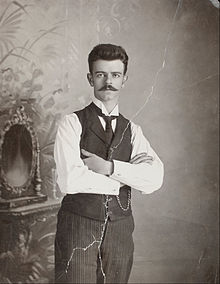Guillermo Kahlo: Difference between revisions
ClueBot NG (talk | contribs) m Reverting possible vandalism by 98.179.157.215 to version by 2603:8081:1502:A3E5:4B75:7378:7B93:F08C. Report False Positive? Thanks, ClueBot NG. (4231920) (Bot) |
very much Tags: Reverted references removed |
||
| Line 16: | Line 16: | ||
'''Guillermo Kahlo''' (born '''Carl Wilhelm Kahlo'''; 26 October 1871 – 14 April 1941) was a [[German Mexicans|German-Mexican]] [[photographer]]. He photographically documented important architectural works, churches, streets, landmarks, as well as industries and companies in Mexico at the beginning of the 20th century; because of this, his work has not only artistic value but also historical and documental importance. He was the father of painter [[Frida Kahlo]]. |
'''Guillermo Kahlo''' (born '''Carl Wilhelm Kahlo'''; 26 October 1871 – 14 April 1941) was a [[German Mexicans|German-Mexican]] [[photographer]]. He photographically documented important architectural works, churches, streets, landmarks, as well as industries and companies in Mexico at the beginning of the 20th century; because of this, his work has not only artistic value but also historical and documental importance. He was the father of painter [[Frida Kahlo]]. |
||
cum. |
|||
== Early life and education == |
|||
Kahlo was born in [[Pforzheim]], [[Grand Duchy of Baden]], [[German Empire]] (now in [[Baden-Württemberg]], Germany), the son of jeweller Jakob Heinrich Kahlo and Henriette Kaufmann.<ref name="Herrera 1983 5">{{cite book |last=Herrera |first=Hayden |year=1983 |title=A Biography of Frida Kahlo |publisher=HarperCollins |location=New York |isbn=978-0-06-008589-6 |page=[https://archive.org/details/frida00hayd/page/5 5] |url-access=registration |url=https://archive.org/details/frida00hayd/page/5 }}</ref> His daughter, [[Frida Kahlo]], maintained that he was of Hungarian-Jewish descent.<ref name="Herrera 1983 5"/> A 2005 book<ref>{{Cite book |title=Fridas Vater: Der Fotograf Guillermo Kahlo |author=Gaby Franger |author2=Rainer Huhle |author3=Juan Coronel Rivera|author4=Städtische Galerie Pforzheim |publisher=Schirmer Mosel |year=2005 |isbn=9783829601979 |page=247 |location=Munich}}</ref> by Gaby Franger and Rainer Huhle traced Kahlo's genealogy, and stated that "despite the legend propagated by Frida," Guillermo did not have [[Hungarian Jews|Jewish Hungarian]] roots, but was born to [[Lutheran]] parents who "came from families accommodated in [[Frankfurt]] and Pforzheim."<ref name="jerpost1">{{cite news |last=Ronnen |first=Meir |date=20 April 2006 |title=Frida Kahlo's father wasn't Jewish after all |publisher=The Jerusalem Post |url=http://www.jpost.com/ArtsAndCulture/Books/Article.aspx?id=19442 |access-date=2009-09-02}}</ref> |
|||
He attended the University of [[Nuremberg]]. His father paid him to travel to [[Mexico]] in 1891 as he did not get along with his stepmother. In Mexico, Wilhelm adopted the Spanish equivalent of his name "Guillermo." In July 1894, he solicited Mexican citizenship.<ref name="Excélsior">{{cite web |last=Talavera |first=Juan Carlos |title=Guillermo Kahlo, revelado |publisher=[[Excélsior]] |url=http://www.excelsior.com.mx/expresiones/2016/02/25/1077260 |access-date=16 March 2016}}</ref> |
|||
== Career == |
== Career == |
||
Revision as of 15:52, 12 April 2023
Guillermo Kahlo | |
|---|---|
 Guillermo Kahlo in 1920 | |
| Born | Carl Wilhelm Kahlo 26 October 1871 |
| Died | 14 April 1941 (aged 69) Mexico City, Mexico |
| Spouse(s) | María Cardena, Matilde Calderón y González |
| Children | 7, including Frida Kahlo and Cristina Kahlo |
Guillermo Kahlo (born Carl Wilhelm Kahlo; 26 October 1871 – 14 April 1941) was a German-Mexican photographer. He photographically documented important architectural works, churches, streets, landmarks, as well as industries and companies in Mexico at the beginning of the 20th century; because of this, his work has not only artistic value but also historical and documental importance. He was the father of painter Frida Kahlo.
cum.
Career

Kahlo's earliest known photograph is from 1897.[1] His first project with Secretary of Finance José Yves Limantour was in 1900.[1] Kahlo usually used large glass plates that measured 8in x 10in to 11in x 14in.[1]
In 1901, he set up a photographic studio, working for El Mundo Ilustrado and Semanario Ilustrado. He was commissioned by the government to do architectural photographs, probably his best work. He also took photographs of churches with other photographers for a six-volume survey in the 1920s.[citation needed] José Vasconcelos published Kahlo's work involving the churches in 1923 through Mexico's Ministry of Education.[2]
Personal life


Kahlo married Mexican-born María de los Dolores Eleuteria Clotilde Cardeña Espino in August, 1893.[3] The night she died giving birth to their third child, he asked Antonio Calderón for his daughter Matilde’s hand in marriage. After the marriage, Kahlo sent his and Maria’s daughters away to be raised in a convent.[citation needed]
Kahlo and Calderón were the parents of seven children, including the painter Frida Kahlo and Cristina Kahlo. Cristina was the only one who had children. Frida once commented that, in her childhood, she would sometimes be present when her father suffered from epileptic seizures and would give him aid.[1]
Kahlo died on April 14 1941 in Coyoacán, Mexico City.
In popular media
Kahlo was played by Roger Rees in the 2002 film Frida.
See also
- Porfiriato
- Casa Azul, the family home now known as the Frida Kahlo Museum
Citations
- ^ a b c d Cite error: The named reference
Excélsiorwas invoked but never defined (see the help page). - ^ CARRANZA, LUIS E.; LARA, FERNANDO LUIZ (2014). Modern Architecture in Latin America: Art, Technology, and Utopia. University of Texas Press. pp. 18–20. ISBN 978-0-292-75865-0.
- ^ "Maria Cardena Genealogy". 2015.
- Coronel Rivera, Juan. et al. Guillermo Kahlo fotógrafo 1872–1941. Vida y obra. CNCA / INBA. México 1993.
Further reading
- Casanova, Rosa. "Guillermo Kahlo: luz, piedra y rostro". Colección mayor. Bellas Artes'. Published, 2013. ISBN 9786074952940
